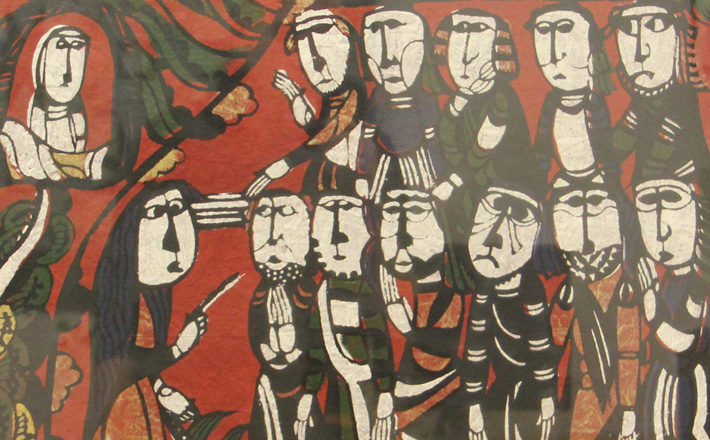Commentary on Luke 24:1-12
How can we believe the unbelievable?
When our assumptions about the world are shaken to the very core, how do we move forward? Even when it is good news, how can we believe the unbelievable? These questions are particularly pressing for the preacher on Easter morning.
In Luke, the cross is a tragedy. Luke emphasizes Jesus’ innocence throughout the passion narratives (22:51-53; 23:4, 9, 14-15, 41, 47). Jesus had done nothing to merit this cruel, public execution. He was innocent of all charges according to Luke. The cross is a display of imperial arrogance and incompetence. As Jesus is passed from ruler to ruler, the frailty and cruelty of Roman power is laid bare. This is not a system of justice but a broken exercise of power that treads upon the weak and the powerless.
In this way, Luke’s Jesus is not alone. He is accompanied by many other anonymous victims of Rome’s imperial violence. In this way too, Jesus becomes a sibling of others unjustly executed by the powerful. Moreover, the cross does not evoke language of ransom like we find in Mark 10:45 and Matthew 20:28. Instead, notice that the first reactions to Jesus’ death are grief and sorrow among those who had gathered to watch a “spectacle” (Luke 23:48).
Like crowds gathered to watch a lynching in their Sunday best, these neighbors of Jesus had looked to the spectacle of empire for some relief or diversion or a violent display of the security a certain kind of empire can provide. Instead, they found a mirror in the cross of Jesus, a mirror that reminds us all that we too can easily become the victims of such vicious, indiscriminate state violence and that we too can join a crowd demanding the death of the innocent or at least join a crowd looking for a “spectacle.”
In Luke, the cross is a tragedy, one that echoes throughout time and space, crossing the boundaries of eras and nations. Jesus’ cross, in this way, is not unique. Jesus’ cross was borne by many others, is borne by many others. In Luke, the cross is a tragedy, a real tragedy, but it is also prologue to good news.
Luke 24 recounts then the resurrection of someone Rome assumed it could snuff out without much effort and without repercussion. These verses recount the moment when our most basic assumptions about life, death, power, and hope are rewritten. Can we believe the unbelievable?
“The women who had come with him from Galilee” (Luke 23:55) arrive early in the morning to prepare Jesus’ body for the grave. (Remind us as you preach that these women are not newcomers in Luke’s narrative; they have been faithful followers and even benefactors of Jesus’ ministry at least since Luke 8:1-3.) As we know, they discover an empty tomb and “two men in dazzling clothes” (24:4) explaining what had happened. They say, “Why do you look for the living among the dead? He is not here, but has risen” (24:5).
In your preaching, I would invite you to dwell on this question. Might this question linger over us day to day? In what ways, do we continue looking for the living among the dead? If we have already been resurrected like Jesus in baptism, we are already participants in this new life. We too are the living, not the dead. Our communities are full of God’s life already!
The women react with fear first and then faith and comprehension. Coming upon an empty tomb, fear strikes them as it should. After all, they had just seen Rome kill Jesus! But when they hear the words of the two messengers, their explanation that Jesus had told them that this would happen, “they remembered his words” (24:8). Perhaps then faith is not just a matter of knowledge but of the courage to believe the unbelievable, to believe in life at the mouth of the tomb, to trust the words Jesus have spoken though they made little sense then and are still confounding right now.
Their faithfulness, their belief, however, is received with incredulity by the apostles. They don’t remember Jesus’ words for some reason. Instead, Luke says, they regarded the women’s testimony as an “idle tale” (24:11); this is striking considering that these women have been some of these least “idle” actors in Luke’s story! They were the ones providing for the needs of Jesus and the twelve. They were the ones who summoned the courage to go to the tomb when the threat of further violence from Roman power loomed over them. They were the ones who believed without having seen the risen Jesus!
Peter is the one exception to this incredulity. He sees the tomb for himself and is stunned, “amazed” at what he has seen.
So, again, how do we believe the unbelievable? In a world ravaged by loss and injustice, how do we believe that the power of the resurrection has already covered us? Do we, like the women, remember Jesus’ words? Do we, like the many of the disciples, consider this all an idle tale? Do we, like Peter, run to see for ourselves?
And what if this narrative is calling us to move beyond mere cognition when it comes to the resurrection in our preaching? Believing in the resurrection is not a matter of mental effort. Such belief does not dwell in the space between our ears. That belief becomes life in our very bones. Such belief ought to transform our everyday. Belief in the resurrection is not just a response on a survey of belief; belief in the resurrection changes our very existence, right here and right now.
It is to such transformations that we will pay attention to next week as we close the Third Gospel and then in the weeks that follow as we turn to Acts.
PRAYER OF THE DAY
Risen Messiah,
Hallelujah! Christ is risen! Christ is risen indeed! Glory be to you, whom death could not defeat. Praise to the savior of heaven and earth. Honor and glory are yours, now and forever, Christ our savior and redeemer. Amen.
HYMNS
Jesus Christ is risen today ELW 365, H82 207, NCH 240
Christ the Lord is risen today ELW 369, UMH 302, NCH 233
Now the green blade rises ELW 379, UMH 311, NCH 238
CHORAL
Surrexit Christus, G. B. Pergolesi


April 16, 2017